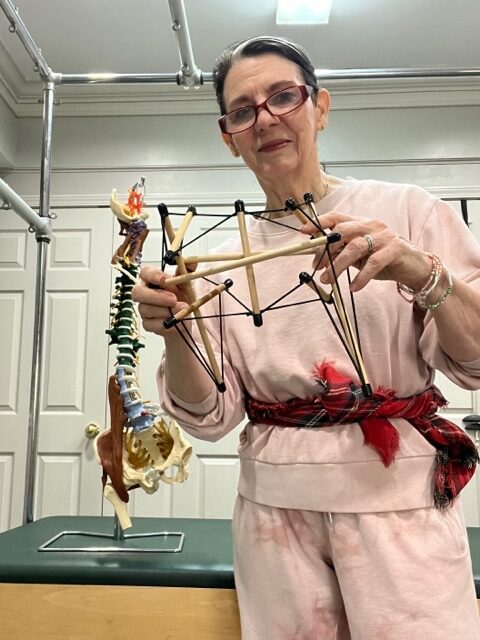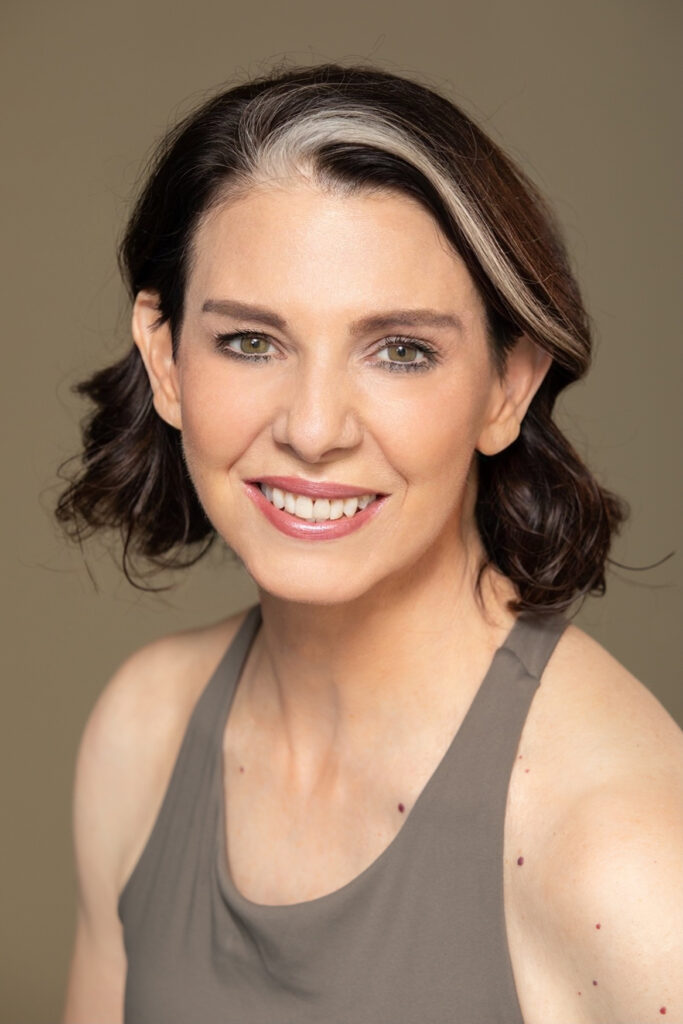Issue #392
Wednesday February 15, 2023
Unraveling Scoliosis From the Torso Hands and Feet:
A Bio tensegrity Approach in Pilates
by Suzanne Martin
Pilates is my modality of choice for many decades to deal with spinal asymmetry and scoliosis for myself and my clients. Several colleagues in Pilates and other body therapie s such as yoga attend to the asymmetry issue as well. An ever-increasing number of both young people and older adults show up at my studio with asymmetries from multiple causes: another essay on that need. The bottom line is that we need all hands on deck since it’s estimated that about eight percent of people over age twenty five and up to sixty-eight percent for those in their sixties, due to degenerative spines, either have or will develop an asymmetrical spine. (Konieczny, 2013)
Many scoliosis teaching models concentrate on muscle balance use. Indeed, Pilates is more than well-known for its “core” work. Since it is true that the body has many muscles (about 602 muscles, 206 bones), why not concentrate on the whole body and its many systems to activate it as Pilates once advocated?
Did you know that what started as an intuition in taming the relentless curves has now finally arrived in evidence? Pilates has come a long way since the Elders taught mainly by oral transmission with little anatomical or movement science knowledge. Contemporary Pilates teacher training now uses more of movement science, embracing current information on the importance of fascia through a bio tensegrity approach, which is particularly useful in teaching about the spine, creating many more possibilities in Pilates.
Muscles are linked by their fascial and neurological functions. The bio tensegrity model moves away from the concept of the neatly stacked vertebrae model to one of a floating vertebral reality, allowing the spinal asymmetry to take life and respond to its environment. Stabilization is necessary, true, along with vertical alignment. And while it is true that there are parts of scoliosis and asymmetry that will change, other parts will not, rigid commands of submission often fail.
This pelvic tensegrity model below illustrates how the bones, seen as struts, relate to moveable, flexible cords to allow three-hundred-and-sixty-degree motion within the constraints of the anatomy. The same is true of the spine.
One of my favorite exercises to address the spinal conundrum is the Straw Exercise, where the client assumes a slumped seated position while the movement educator (ME) places a flat hand upon the client’s head. Verbal and tactile cues then guide the client to roll forward onto the Sit-Bones, press firmly down upon them, and then feel the imaginary (or tactile cueing hand) hand lift the skin of the low back, travel up the lampshade of the rib cage, up through the yolk of the shoulder girdle, reaching the turtle neck out of its shell and up through the top of the head. The ME then asks the client to breathe in and get tall three times, afterwards releasing the hand from the client’s head.
The exercise above exemplifies a Body Skill where the client learns from the ME to use a motion for release and renewal from daily gravitational forces. Clients find empowerment along with their natural elongation, activating the spine, housed by the core, largely due to our innate righting reflex that allows those of us with a relatively normal neurological system to find verticality.
In original European scoliosis training physiotherapist Katerina Schroth describes trunk right-angle-breathing, and in traditional Pilates tradition, posterior-lateral breath concepts are standardly taught.
In scoliosis specialized education, convex areas of the torso, the core, receive much attention, attributing many convex curve classifications according to the authority conferring the classification.
Core is a confusing term. In my first book, an editor translating from English to another language contacted me to ask what it could be. Is it like an apple core? A nuclear core? Yet the core, even if apple or nuclear, are not lone actors. How do the appendices, the limbs and head enter the equation?
Looking strictly at the trunk alone, the core, one helpful explanation that dovetails with bio tensegrity concepts is the image of a dented soda can, made famous by breathing physiotherapist Mary Massery. The fascial wrappings and under-the-skin tugging that constitute the adherent underlying concave areas come alive with not just breathing or directed breathing, but also connecting the five diaphragms that regulate internal trunk pressures that help to re-shape and open the imploding body areas. Heat, repetitive motion, and tensile stretch help to transform physicality from dense, lacking in circulation areas into resilient, floating, and dynamic vertebral support structures.
A favorite exercise for core experimentation is the balloon exercise, which adds a double bonus due to its ability to help vagal tone. In a supine position, place one hand upon the lower ribs, the other upon the abdomen. Then start rhythmic inhalation into the chest, neck and head while allowing the abdomen to deflate. Next, reverse the action and allow the sternum to deflate while gently distending the abdomen toward the ceiling, not towards the pelvic floor. Repeat several times.

What about the core connection to the rest of the body? Current fascial anatomic research done by the Stecco family reveals connections from the hands and feet into the shoulders and hips via fascial tissue called retinacula. My favorite image for these connections is of DaVinci’s Vitruvian man. It is useful in the current trend in Standing Pilates. Most people know the Da Vinci man.
Tell your client or class to stand in an easy Pilates “V” with the legs just a bit past hip width. Reach the arms, with palms forwards about thirty degrees ahead of the torso as if to press the palms on a wall in front. Next cue the feet to feel as if sucking up a raisin in the arches into the hips. Then cue the arms to feel as though holding balls in the palms that are sucking up into the shoulders.
Then include general cues of feeling the magnets between the Sit-bones, the pelvic parachutes from the front and back pelvic floor floating towards the head, and smile! Now the full deep fascial front connection is integrated with the spiral connections.
Next, ask the class to “Breathe in, get tall…. Exhale, get taller…” the magic three times. Of course, repeat if you wish.
Connecting the core to the limbs enhances exteroception, the perception of ourselves becoming large in the environment.
Add these ideas to your next mat class or client session, watch and savor the unraveling of the torso from the limbs.
I have faith in you!
1.
Konieczny MR, Senyurt H, Krauspe R. Epidemiology of adolescent idiopathic scoliosis. Journal of Children’s Orthopaedics. 2013;7(1):3-9. doi:10.1007/s11832-012-0457-4
Dr. Suzanne Martin has been practicing Pilates for over 30 years. She is a doctor of physical therapy, exercise physiologist and a gold-certified Pilates expert with a home studio in Alameda, California. An international presenter, she blends art and science, into her writing and instruction. She has been Lead Physical Therapist for over 20 years with Smuin Ballet. As founder of Pilates Therapeutics LLC she teaches worldwide on the subjects of spinal asymmetry, cancer restoration, foot management and performing arts enhancement. Look for her latest publication from Handspring Publishers, Spinal Asymmetry and Scoliosis; Movement and Function Solutions for the Spine, Ribcage, and Pelvis, available on the Pilates Therapeutics web site. For further information and to see her teaching schedule, go to www.pilatestherapeutics.com. It is never too late to be what you might have been. – George Eliot
The only sin is mediocrity. – Martha Graham




